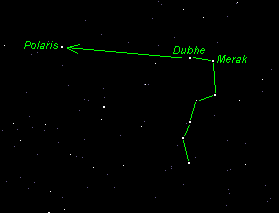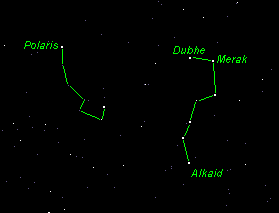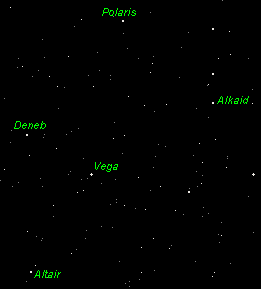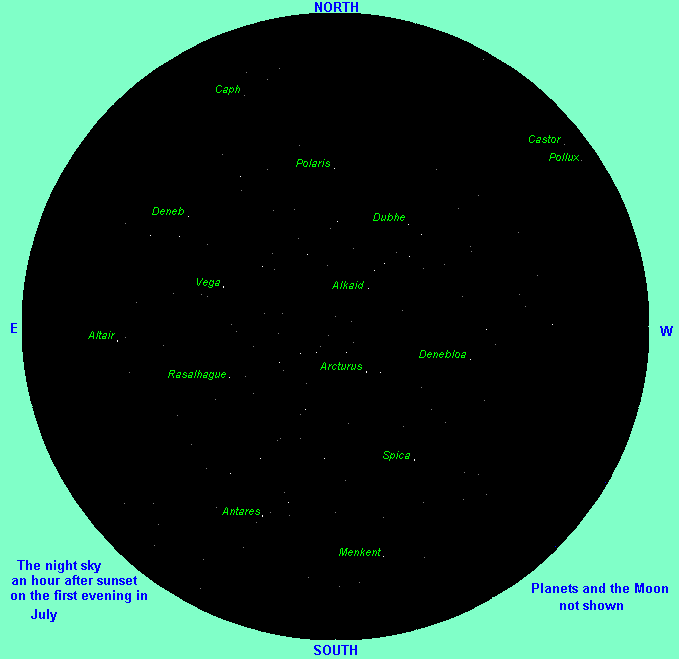This month we have a meteor shower and the Earth reaches its most distant position from the Sun. More on all that later. First let's make sure you know your bearings in space.
If you live in the Northern Hemisphere the most important star in the night sky is Polaris - known to most people by its more descriptive name of "North Star". Actually, both names are very descriptive. The Earth's spin is such that the axis of our planet's rotation points to Polaris, so at all times Polaris hovers over the North Pole. Another, more useful, way to think of it is that Polaris always points north. That's why it's called the "North Star". Every scout, camper, or star trek fan should be able to find Polaris, assuming it isn't covered by clouds.
Some people, mistakenly, believe that the North Star is the brightest
star in the sky. Boy are they wrong!  There are dozens of stars
brighter than Polaris.
There are dozens of stars
brighter than Polaris.
|
Indeed, the best way to find Polaris is to use
some of the brightest stars that point to it. So the first thing
you must learn to identify is the Big Dipper. Some people, mistakenly,
call the Big Dipper a constellation. The Big Dipper is only a
part of a bigger constellation called Ursa Major (the Big Bear)
but the Dipper part is so obvious that we can just think about
the Dipper.
To find the Big Dipper search the sky for an obvious box with an arc of stars coming off one corner. Look for this image on the right. Understand that the sky rotates throughout the night (and day) so this pattern can be at any angle. Regardless, on any clear night you should be able to find the Big Dipper without difficulty. (Its dimmest star has a magnitude of 3.) |  |
|
If you connect the dots of the Big Dipper you will see the obvious
pattern of a "dipper" or bowl with a handle.
Most importantly,
the two stars farthest from the handle point to Polaris. They
are often nicknamed "the Pointers" but their correct
names are Merak and Dubhe. If you imagine a line from Merak through
Dubhe and beyond, you will soon arrive at a star of similar brightness.
That's Polaris - the North Star.
|  |
|
Polaris is the brightest star in the Little Dipper which, like
the Big Dipper, is not a true constellation. The Little Dipper
is part of the constellation of Ursa Minor (the Little Bear).
One a clear night you can make out the dim stars that make up the rest of the Little Dipper. Notice that the handle of the Little Dipper bends the opposite way from that of the Big Dipper. Also, don't confuse Polaris, at the end of the Little Dipper, with Alkaid, at the end of the Big Dipper. |  |
While we are thinking about the northern sky and "fake constellations", I'd like to draw your attention to the stars of the Great Summer Triangle.
|
Look to the southeast of Polaris and you will notice
three stars that immediately stick out - Vega, Deneb and Altair.
Together they make up the Great Summer Triangle. Each of those
three stars is in a different constellation.
Vega is the brightest star in Lyra the Harp and if you look carefully you will see the harp as a diamond-shaped pattern just to the southeast of Vega. Deneb is in the tail of Cygnus the Swan. This constellation is sometimes called the "Northern Cross" because it makes that pattern. The swan's wings arc left and right while its long neck extends all the way into the center of the Great Summer Triangle. Altair is the brightest star in Aquila the Eagle. The Great Summer Triangle will dominate the night skies for several more months so take some time to become familiar with it. |  |
The Dipper and Polaris are always up there but these warm summer nights are an ideal time to learn them.
Around the 4th of July the Earth reaches aphelion - the position in its orbit at which it is farthest from the Sun. Most folks are surprised to learn that our world is farthest from the Sun in mid-summer! (Summer in the Northern Hemisphere, that is.) The seasons are caused by the tilt of the Earth, not by the distance between the Sun and Earth. Folks in the Southern Hemisphere will be experiencing winter during a northerner's summer because at that time the Earth's North Pole is tilted more towards the Sun, allowing the northern part of the Earth to receive plenty of warmth (while the Southern Hemisphere is cheated out of its sunlight due to the long nights). The Earth's orbit, including its aphelion, has no significant affect on the Earth's seasons.
The South Delta-Aquarids meteor showers peak around July 29th. If you happen to be outside on or around that that, sometime after midnight, you might see some meteors in the southern sky but don't go out of your way to find them. (Instead, wait until next month for the best meteor showers of the year!  )
)
|
Your sky map for the month of JulyHere's a map of the clear, night sky as seen from the center of the USA on the first evening of this month, an hour after sunset. Specifically, this is the view of a clear sky from a latitude of 37N. Star-gazers farther north, such as in Minneapolis, Chicago and most of Europe, will have more of the northern sky visible and the southern sky will be obscured by the horizon. Vice versa for those who are farther south. The stars will not change position relative to each other, however, throughout the month, the Moon and planets will wander, so they are not shown. Only objects of magnitude 4.0 and brighter are displayed.
Here's a reverse color image of the map that will be easier on your printer. |  |
On July 4th, 1054 a star in the constellation
of Taurus exploded as a supernova! (Nice fireworks.  ) It was very
bright and recorded by Chinese astronomers. Actually, the star
went supernova six thousand years before but it took that long
for its light to reach us. The remnants of that explosion can
be seen today, with a good telescope, as the Crab Nebula.
) It was very
bright and recorded by Chinese astronomers. Actually, the star
went supernova six thousand years before but it took that long
for its light to reach us. The remnants of that explosion can
be seen today, with a good telescope, as the Crab Nebula.
In the mid 19th century photography was first being applied as a tool in astronomy. On the night of July 16th 1850 the folks at the Harvard Observatory took the first photograph of a star other than our Sun - Vega. Two weeks later, on the 28th of July, the first photograph of the Sun during a total eclipse provided the evidence of the Sun's corona.
"A small step for (a) man. A giant leap for mankind." occurred on July 20th 1969 when Neil Armstrong set foot on the Moon. (He was so overcome with excitement that he blew his historic line by forgetting to include the "a" in his sentence.) Edwin Aldrin soon followed Neil down the ladder of the Lunar Excursion Module to become the second man to stand on the Moon. They collected about 20 kilograms of lunar rocks and soil during their twenty-one and a half hours on the Moon before returning to the Command Module where the third (often forgotten) member of the Apollo 11 team, Michael Collins, had patiently waited orbiting the Moon (while collecting mapping data that would be important for subsequent lunar landings).
On July 20th 1976 Viking 1 landed on Mars and returned the first images taken from the surface of the Red Planet.
The first fragments from Comet Shoemaker-Levy 9 began to impact Jupiter on July 16, 1994.
I hope you found the Night Sky this Month to be helpful and educational. I invite you to return here monthly for new information.